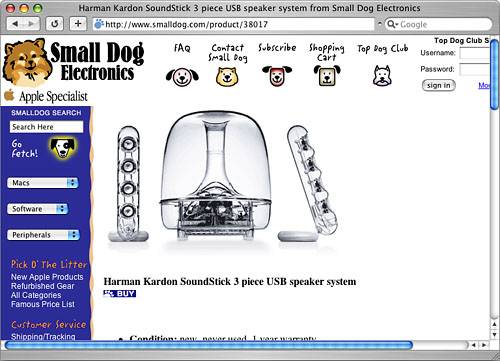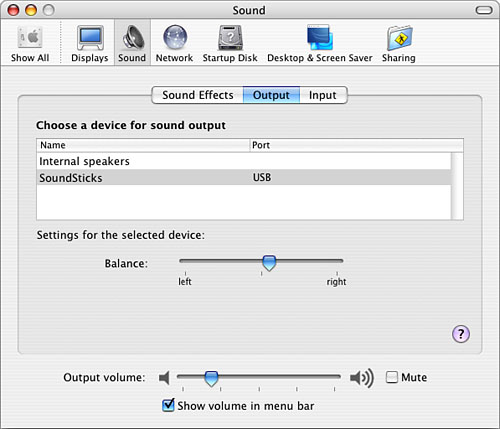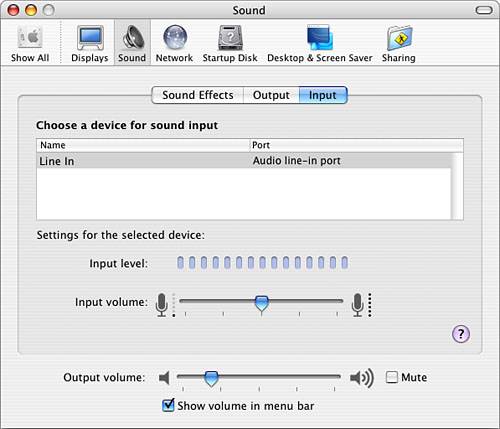Finding, Installing, and Using Speakers
Sound is an important part of the Mac experience. Adding speakers to your system is a good way to enhance the experience of music, movies, games, and other multimedia.
The five basic types of speakers you might be able to use with your Mac include
Built-in? The built-in speakers on eMacs and older iMacs provide fairly good sound. The built-in speakers in PowerBooks and iBooks are okay as long as you are on the move and can't use anything better. But the built-in speakers on other Macs are pretty sorry.
Analog? Analog speakers connect to the Mac's headphone or speaker jack. You can find very high-quality computer speakers, some of which rival their home stereo counterparts in sound quality.
Apple Pro? Some Macs, such as the iMac, include a jack for Apple Pro speakers. These machines include a pair of Apple Pro speakers, also known as eyeball speakers. These are analog speakers that offer decent sound quality and a very stylish design.
USB? Digital speakers use the USB interface to connect to your Mac. USB speakers also offer excellent quality.
Digital 5.1 Surround Sound? If you are lucky enough to have a Power Mac G5 or you install a 5.1 audio card in a Power Mac G4, you can use digital 5.1 surround sound speakers. These provide the ultimate in sound quality and enable your Mac to match a home theater's sound output.
Digital Surround Sound Is LackingIt's a shame that only the Power Mac G5 supports digital surround sound. After many years of providing unmatched audio out of the box, the Mac has trailed Windows machines for some time in the area of audio. Many more 5.1 surround sound cards are available for Windows machines, and many Windows desktops support 5.1 out of the box. With its emphasis on leading-edge digital media capabilities, it is too bad that most Macs are limited to simple stereo audio. (For example, when you watch a DVD on all Macs except the G5, you are limited to stereo sound output and the cool surround sound effects enabled by DVD are missed.) Hopefully, Apple will introduce 5.1 support in all Mac models soon. |
Choosing and Installing Speakers
As with other system components, choosing speakers is primarily a task of balancing how much you want to spend versus how demanding you are in terms of quality. In either analog or USB, speaker sets come with a number of speakers. A basic set has two speakers; however, unless you have a very small budget, you should get a set that also includes a subwoofer. More advanced digital 5.1 speaker sets can have six speakers to provide full surround sound.
NOTE
As mentioned earlier, surround sound is an area in which Macs trail PCs. Sound cards that provide true surround sound are available for PCs, but at the time of this writing, few are available for the Mac.
A good choice for many systems is Harman Multimedia SoundSticks (see Figure 23.6). These USB speakers provide excellent sound, and they are among the best-looking speakers around. Because they are USB based, all modern Macs can use them.
Figure 23.6. SoundSticks sound as good as they look.

If you have a Power Mac G5, you should get a set of speakers that takes advantage of the advanced audio capabilities of these machines to provide true 5.1 digital surround sound.
Installing speakers requires that you provide power to the subwoofer, attach all the satellite speakers to it, and then connect the subwoofer to your Mac (via the headphone or speaker jack, via a USB port, or to the digital audio out port). If you use Apple Pro speakers, you attach them to the Apple Pro speaker port.
Using Speakers
You can control the audio output of your system in several ways.
Some speakers come with volume and other controls on one of the satellites.
You can control the system volume of your Mac through the keyboard volume controls on the Apple Pro keyboard or on the PowerBook's and iBook's built-in keyboard. Other keyboards, such as the excellent Logitech Duos, provide volume wheels that you use to control your system's volume.
You can also use the Sound pane of the System Preferences utility to set sound levels. At the bottom of the pane, you can use the Output volume slider to set the general sound level for your system, including muting it. You can also choose to install the Volume menu on the Mac OS X menu bar. If you do so, you can set the volume level by clicking the speaker icon on the menu bar and setting the volume level with the slider.
NOTE
You can also control volume using controls within specific applications, such as iTunes or iMovie. When you do so, the volume control in the application changes the volume of that application's output relative to the system volume level.
When you use the volume controls on an Apple Pro keyboard, you change the system volume level.
The Sound pane of the System Preferences application has three tabs: Sound Effects, Output, and Input. |
On the Sound Effects tab, you can set the relative volume level of alert sounds, the alert sound you want to use, the audio controller through which alert sounds play, whether user interface sound effects play, and whether you hear feedback when you change the volume level using the keys on the Apple Pro or other keyboard.
Select the alert sound you want to use by clicking it on the list. You then hear a sample of the sound you select. When your Mac needs to get your attention, it plays this sound.
One of the nice features of Mac OS X is that, with some speakers such as USB SoundSticks, you can set the alert sound to play through the Mac's internal speaker while the rest of the sound plays through the external speakers. You do this by setting "Internal speakers" on the "Play alerts and sound effects through" pop-up menu. This means that alert sounds play through the Mac's built-in speaker(s) rather than through the external speakers, such as SoundSticks. This prevents you from being jarred by an alert sound when listening to loud music or movies.
NOTE
If you use external analog speakers that get their output from the speaker jack on your Mac, you can't choose those speakers separately from the Mac's built-in audio controller because the Mac's controller controls the output to the speaker jack. Only when you use USB or digital speakers, such as the SoundSticks, or when you install a PCI sound card, can you configure separate sound output devices.
Set the volume level of alerts by using the "Alert volume" slider. If you do have alerts play through internal speakers while other sound plays through external speakers, you likely need to set the alert volume level relatively high to be able to hear it over the sound coming from the external speakers.
If you check the "Play user interface sound effects" check box, you will hear sound effects for various actions, such as when you empty the Trash.
If you check the "Play feedback when volume keys are pressed" check box, you will hear a sound when you change the system volume level using the volume keys on your keyboard. The louder the volume setting, the louder the feedback sound.
Use the Output tab to select the output devices you want to use to play sound other than system alerts (see Figure 23.7). When you install additional devices, such as SoundSticks, you see each device in the output device list. Choose the device you want to use to play sound and then configure the settings for that device. The settings you have depend on the device you have installed. For example, with SoundSticks, you can control the balance of the satellite speakers.
Figure 23.7. The Output tab of the Sound pane of the System Preferences utility enables you to configure the balance of SoundSticks satellite speakers.

Use the Input tab to configure sound input devices, such as the audio in port or USB microphones (see Figure 23.8). A list of all sound input devices appears in the upper part of the pane. You can use the "Input volume" slider to set the input volume level for the selected device. Use the "Input level" display to monitor the input volume being received by the input device. The "blips" show you how "loud" the input sound is. A blip remains at the highest level of sound input to show you where the maximum is. Generally, you should set the level so that most of the sound is coming in at the middle of the range.
Figure 23.8. You can use the input sound to set the input volume for USB microphones and other input devices.








